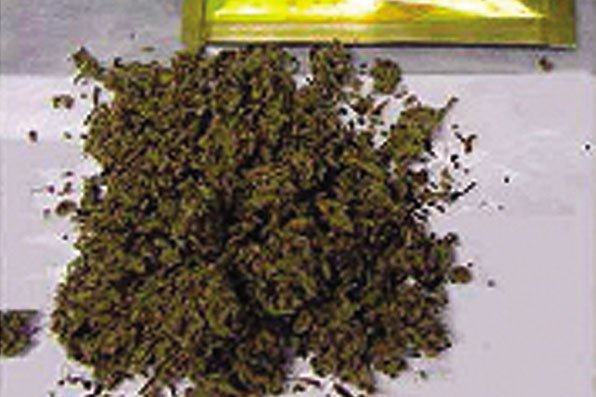A crumbly mixture resembling dead seaweed, Italian seasoning and
catnip promises a legal means of getting high, but it could wind
users up in the hospital. Marketed as incense or potpourri in
palm-sized pouches with colorful logos,
”
fake pot
”
products are known to cause high blood pressure, hallucination,
agitation, vomiting, tremors, increased heart rate and chest pain.
Cases have already started to appear in Gilroy.
A crumbly mixture resembling dead seaweed, Italian seasoning and catnip promises a legal means of getting high, but it could send users to the hospital.
Marketed as incense or potpourri in palm-sized pouches with colorful logos, “fake pot” products are known to cause high blood pressure, hallucination, agitation, vomiting, tremors, increased heart rate and chest pain.
Cases have already started to appear in Gilroy.
“The police department is aware there’s been several juveniles who required medical aid as a result of ingesting synthetic marijuana,” said Gilroy Police Department Sgt. Chad Gallacinao.
He confirmed two businesses in Gilroy were suspected of selling the products, but was unable to specify which stores were involved, or what brands were consumed.
Synthetic marijuana is an unregulated knockoff of the real thing; a concoction of mystery plant material that’s been coated with research chemicals formulated to mimic the effects of THC – marijuana’s active ingredient.
The possible damaging side effects have prompted the U.S. Drug Enforcement Administration to take steps to ban the products by the start of the new year, but substances have been raising concern for poison control centers in the Midwest since 2009.
Common brands of fake marijuana such as “K2” and “Spice” generally go for $30 to $40 per 3 gram bag.
The DEA said during the past year, smokable herbal blends – which are not regulated by the FDA for human consumption – are marketed as “legal” and offering marijuanalike highs.
The employees for The Rock Zone, a smoke accessory and piercing shop on 1323 First Street in Gilroy, were amicable but immediately declined to comment on the situation. They indicated to a display case near the front of their neon-lit lit showroom, which contained the Spice product.
A sign that read “Spice will be banned after Dec. 24 from Rock Zone” was posted on the glass.
At Cigarland at 620 Tennant Station in Morgan HIll, an employee said he carried Spice and K2, and suggested coming down to check them out.
“We have a few selections,” he said. “About six different kinds.”
When inquired if he knew about the DEA’s ban that may soon go into effect, however, the employee said he had nothing to say, and did not want to offer any further comment.
The guarded stance wasn’t restricted to Gilroy. Paramount Imports smoke shop in San Jose had a similar response, and was unable to offer any opinions.
The Sub in San Luis Obispo carries Spice and K2 and engaged in conversation more openly and comfortably. They acknowledged awareness of the DEA’s actions, but also pointed out the products aren’t illegal – yet.
Principal John Perales at Christopher High said administrative leaders are aware of the products, but have never seen it on campus.
“Absolutely not,” he said. “Is it coming our way? Perhaps. But I have not seen any of it in Gilroy.”
Perales said it’s been on his radar since early in the school year of 2009-10 when a he heard of a few cases in San Jose.
On a larger scale, the DEA issued a Nov. 24 news release announcing it was moving to emergency control of synthetic marijuana, plus five chemicals used to make it: JWH-018, JWH-073, JWH-200, CP-47,497 and cannabicyclohexanol.
“Makers of these harmful products mislead their consumers into thinking that ‘fake pot’ is a harmless alternative to illegal drugs, but that is not the case,” said DEA Acting Administrator Michele M. Leonhart in the release.
Jessica Wehrman, communications manager for the American Association of Poison Control Centers, said centers across the nation have received more than 2,300 calls about synthetic marijuana since 2010.
“We’re hearing about more people arriving in hospitals with severe effects from it,” said Freda Rowley.
She is a certified specialist in poison information with the California Poison Control System, which provides data on the possible harmful side effects of synthetic marijuana.
“It’s a public health issue … people arrive in the (emergency room), have profound symptoms and the doctor goes, ‘What are you talking about?’ Then the doctor calls the poison control center and says, ‘Do you know what this is?’ ”
Rowley said “fake pot” is attractive to users since it hits the same receptors as marijuana and goes undetected in drug screens.
“Seriously, it’s like you know you’re not dying, but you say you are, and you feel like you are,” wrote a user who reviewed the product Spice on a website called “The Legal High – Smoking Reviews & Legal Highs.”
“My cousin had a 2.5 hour trip on Friday night. She got this vacant look on her face, and she didn’t know where she was, or what was going on, or why she felt that way, and her body was completely numb,” the reviewer wrote.
“This is bad stuff,” said DEA spokesman Rusty Payne. “There’s a reason why we did this.”
In a minimum of 30 days, the DEA will issue a final rule to temporarily control the chemicals for at least a year, with the possibility of a six-month extension.
The chemicals will be designated as Schedule 1 substances – the most restrictive category reserved for unsafe, highly abused substances with no medical usage, according to the DEA.
The effectiveness of the ban has come under question by the Drug Policy Alliance – which describes itself as the nation’s leading organization promoting policy alternatives to the drug war that are grounded in science, compassion, health and human rights.
They conjecture if synthetic marijuana is banned instead of being regulated, studied and controlled, it could possibly spur a growing black market of chemically tweaked imitators.
“DEA can come back and try to ban it every single time,” said Bill Piper, director of National Affairs for the DPA. “We could be doing this for the next 50 years.”
Piper said there’s almost an infinite version of the original that makers can just keep producing.
The problem, Rowley said, is the DEA can only ban what it knows exists chemically.
So once someone knows how to make synthetic marijuana, she explained, they can rearrange the building blocks back with slightly different chemicals.
“We could see a whole other batch come through,” she said. “A different molecule over here, a different molecule over there … (makers) can really kind of play with it and change it just enough to make something different.”
She compares the process to building Lego toys.
“They’re getting more creative,” said Rowley, mentioning newer creations such as “Black Mamba” and “Spike Diamond.”
That is apparent on one synthetic marijuana website.
The headline on k2incense.org/ states, “Two NEW K2 products, not covered by any bans.”
On the “buy K2 incense” link, viewers are taken to a page with options to buy three varieties of Original K2 Incense. Subtext in smaller font beneath the logo reads, “to be discontinued Dec. 15! Buy while supply lasts … to be banned world-wide on Dec. 18th.”
To the immediate left of Original K2 Incense is another option to purchase “legal” versions of K2 “everywhere”. The subtext reads “100 percent legal everywhere on the planet. Not covered by any bans.”
Rowley said it’s just common sense, and emphasized caution.
“People who use these types of meds are always looking for the next best thing,” she said.
Trying a product for the sake of trying it, she rationed, isn’t worth a trip to the emergency room.
“People will end up getting hurt by it – and have.”













